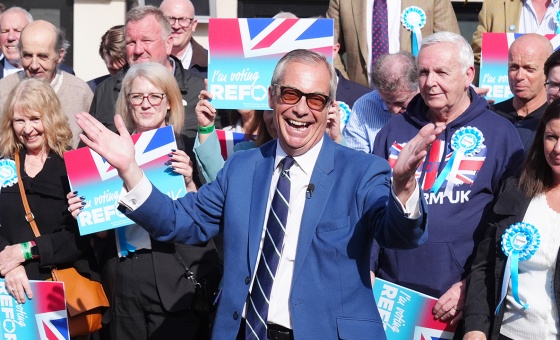This is the last article you can read this month
You can read more article this month
You can read more articles this month
Sorry your limit is up for this month
Reset on:
Please help support the Morning Star by subscribing here
The ugliness of a building is a subjective assessment, and one that tends to change as certain styles go in and out of fashion. However, we can talk of the ugliness of a building’s purpose.
Take London’s Shard. Owned by the Qatari government, which has just added Canary Wharf to its property portfolio, it serves as a plaything of the super-rich, with luxury hotel and restaurant and as-yet-unsold penthouse apartments.
In the context of a severe housing crisis, this grotesque building takes on a dystopian air. The tower lurks over the city’s skyline, a constant reminder of current economic realities.
There is a glut of new towers going up around London, most of which are as socially unnecessary as the Shard. London Mayor Boris Johnson has been happy to waive the most derisory of affordable housing requirements for major projects on “viability” grounds. Developers are able to plead “commercial sensitivity” to justify their questionable figures. “Fully private block with no social housing,” boasted one new development in Greenwich to potential “off-plan” investors.
The conversion of Tottenham Court Road’s Centrepoint tower into flats for the rich may feel ironic to those who remember it becoming a focus point of protest against homelessness as far back as 1974.
The fate of the brutalist Balfron Tower, built in Poplar, east London in the late ’60s to a design by the famed architect Erno Goldfinger, seems just as insulting as the Shard’s rise. This Grade II-listed tower is a reminder that London’s most high-profile building projects were once for a very different purpose — to house its working-class citizens.
Balfron has been cleared of social tenants — “decanted,” in the language of the day — and is being refurbished and sold off as private flats more befitting its “iconic” status. It has become synonymous with the idea that certain types of property — and certain types of view — are not good enough for normal people.
The building also tells us a lot about the narrative of social housing in recent years. After years of neglect and underinvestment by a cash-strapped Tower Hamlets Council, ownership of the tower was transferred, along with other local estates, to housing association Poplar HARCA, in 2007.
Residents were promised new kitchens and bathrooms, alongside new entry systems and greater investment for the area, and voted in favour of the transfer.
Poplar HARCA initially claimed that residents in the Balfron would be able to move back in after refurbishment, but eventually admitted that the whole block would need to be sold off to private developers.
The block’s sale will “serve a catalyst to revitalise the local community,” according to Rick de Blaby, the chief executive of United House Developments, whose website claims the tower will be refurbished “in a manner that is in keeping with Goldfinger’s original vision for the space.”
Fellow redevelopers “luxury residential property” company LondonNewcastle prefer to concentrate on the tower’s “edgy” appeal, pointing out that it has appeared in a gritty music video for Oasis and Danny Boyle’s apocalyptic zombie thriller 28 Days Later.
The tower’s proximity to Canary Wharf will prove popular with architecturally savvy financiers and buy-to-let speculators.
Those who once lived there are less happy.
“It has become an icon for privatisation,” says former resident Michael Newman.
“For the most beautiful building with an incredible potential to develop and sustain a vibrant community, to be sold off to the rich, and this to be celebrated in the architectural press — this is the sign of our times.”
Also symptomatic is who has been living in the block as it awaits its new rich owners. Alongside property guardians happy to give up tenancy security for cheap rents, the Bow Arts Trust brought in artists as residents to “celebrate” those who once lived there, provided the work remained vague enough not to feature the plight of the departing tenants.
This move backfired, with Oliver Wainwright summing up the process in the Guardian as a “live gentrification jamboree.” Not the coverage the developers would have been hoping for.
In fact, the wider background to this privatisation party has been one of local people fighting back. The New Era estate in Hackney, east London, became a focal point in the fight against gentrification. Protest and campaigning led to a humiliating climbdown by the US asset management firm Westbrook.
Many have been inspired by the work of the Focus E15 mothers, whose occupation of the Carpenters Estate brought stark attention to post-Olympics attempts at social cleansing in Newham. Focus E15 mothers will be among those leading today’s March for Homes, when people will march on City Hall to demand affordable rents, a new building program and an end to the sell-off and demolition of social housing.
“We are not marching for the electoral politicians,” said Focus E15 spokeswoman Saskia O’Hara. “We are marching to inspire people to take up the fight for housing.”
One former Balfron leaseholder, Vanessa Crawford, is encouraged by the new wave of activism and only wishes it had happened sooner “so that a campaign could have started while tenants were resident.
“The insidious creep to total privatisation over more than four years has precluded this.”
While it may be too late to save Balfron Tower from its fate, it must not be allowed to become a monument to a past era. We must all keep on campaigning, organising and protesting to ensure that future Londoners can look up and see a skyline that does not exclude them.
Today’s march would be a good place to start.









